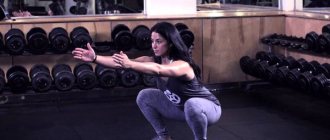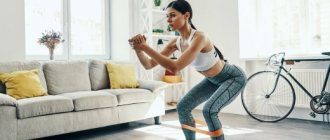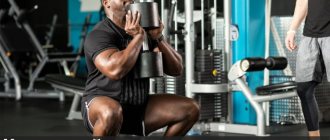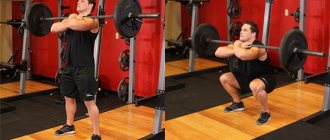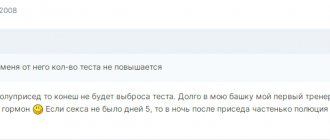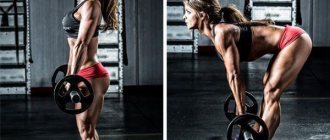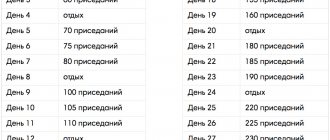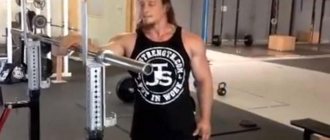Many people consider squats without weights to be a useless exercise. There are arguments like that we walk with our body weight every day, therefore we cannot build muscles with it. On the one hand, indeed, the resistance for significant hypertrophy will be too small. But on the other hand, the unweighted squat helps improve technique, strengthen muscles and ligaments, and achieve the functional state necessary for running and other endurance sports. It also prepares the body for more “conditional” types of squats.
Pros and cons of weightless squats for men and women
Benefit
- This exercise helps you develop your squat technique. It is easiest to learn how to squat with a straight and tense back;
- Squatting without weight teaches you to move with full range of motion in your joints;
- Strengthens the muscles of the legs and buttocks;
- Increases ankle mobility;
- Helps in the prevention of ankle and foot injuries;
- Serves as both a good exercise for fitness and appearance, and an option for general physical training athletes;
- Improves blood circulation in the pelvic organs;
- Recommended as exercise therapy for those at high risk of prostatitis in men and inflammatory gynecological diseases in women;
- Can be performed if axial load on the spine is not recommended.
Harm
- Movement can be dangerous if there are knee injuries, hip joints hurt, or the arches of the feet and ankles are inflamed from running;
- With a long thigh and short lower leg, learning the technique is quite problematic;
- On the modern Internet, it serves as a reason for battles - some teach to squat with the pelvis pulled back, others - with the knees spread to the sides; it is easy for a beginner to get confused in these subtleties;
- It really won't help to become a mass monster at home;
- Increases strength indicators only to a limited extent.
Squats Without Weight from LvL 1 to LvL 80 (Which is YOURS?)
Monthly squat plan
In order to achieve the maximum effect from squats, there must be dynamics in daily exercises. You need to increase the number of repetitions each time.
We offer a universal monthly plan, thanks to which you will definitely get your legs in shape and tighten your buttocks.
| Week 1 | Mon | W | Wed | Thu | Fri | Sat | Sun |
| 1 approach | 10 times | Rest | 10 times | Rest | 10 times | Rest | 10 times |
| 2 approaches | 10 times | Rest | 10 times | Rest | 20 times | Rest | 10 times |
| 3 approaches | 20 times | Rest | 15 times | Rest | 20 times | Rest | 20 times |
| 4 approaches | 20 times | Rest | 15 times | Rest | 20 times | Rest | 20 times |
| 5 approaches | 10 times | Rest | 10 times | Rest | 10 times | Rest | 10 times |
| Total: | 70 times | 60 times | 80 times | 70 times | |||
| Week 2 | Mon | W | Wed | Thu | Fri | Sat | Sun |
| 1 approach | 15 times | Rest | 10 times | Rest | 15 times | Rest | 15 times |
| 2 approaches | 20 times | Rest | 20 times | Rest | 20 times | Rest | 20 times |
| 3 approaches | 20 times | Rest | 20 times | Rest | 30 times | Rest | 20 times |
| 4 approaches | 20 times | Rest | 20 times | Rest | 20 times | Rest | 20 times |
| 5 approaches | 15 times | Rest | 10 times | Rest | 15 times | Rest | 15 times |
| Total: | 90 times | 80 times | 100 times | 90 times | |||
| Week 3 | Mon | W | Wed | Thu | Fri | Sat | Sun |
| 1 approach | 20 times | Rest | 15 times | Rest | 20 times | Rest | 20 times |
| 2 approaches | 20 times | Rest | 20 times | Rest | 25 times | Rest | 20 times |
| 3 approaches | 30 times | Rest | 30 times | Rest | 30 times | Rest | 30 times |
| 4 approaches | 20 times | Rest | 20 times | Rest | 25 times | Rest | 20 times |
| 5 approaches | 20 times | Rest | 15 times | Rest | 20 times | Rest | 20 times |
| Total: | 110 times | 100 times | 120 times | 110 times | |||
| Week 4 | Mon | W | Wed | Thu | Fri | Sat | Sun |
| 1 approach | 20 times | Rest | 20 times | Rest | 25 times | Rest | 20 times |
| 2 approaches | 30 times | Rest | 25 times | Rest | 30 times | Rest | 30 times |
| 3 approaches | 30 times | Rest | 30 times | Rest | 30 times | Rest | 30 times |
| 4 approaches | 30 times | Rest | 25 times | Rest | 30 times | Rest | 30 times |
| 5 approaches | 20 times | Rest | 20 times | Rest | 25 times | Rest | 20 times |
| Total: | 130 times | 120 times | 140 times | 130 times |
Don't forget that sports not only makes you more beautiful, but also raises your self-esteem. Now you know what to do. Hurry up and start your workout!
Execution technique
- Place your feet as you would feel comfortable sitting on a low chair;
- For most people, this is plus or minus the width of the pelvis;
- Extend your legs at the knees and hips;
- Straighten your back;
- Tighten your abs and pull them inward so that your back remains stable throughout the movement;
- Push your knees to the sides and lower your pelvis down so that the hip joint is below the plane passing through the center of the knee joint;
- Sit down;
- At the bottom point, tighten your buttocks and begin to stand up;
- Straighten your legs completely at the knees and hip joints;
- Repeat as many times as necessary.
Variation: You can perform the exercise by pushing your pelvis back if you want to focus on your glutes, in which case the weight shifts to your heels. This option is not recommended for severe lumbar lordosis and “dipping” of the pelvis.
bodymaster : Squats without weights
How to do squats correctly:
- Stand up straight with your knees straight and your hips slightly wider than your shoulders.
- Direct your gaze forward with a neutral head position.
- Bring your chest forward and up, and bring your shoulder blades together, as if you are squeezing something between them.
- Pull your shoulders back a little.
- Keep your torso in a straight position. The spine must be kept rigid throughout the entire movement.
5 Best Squats for Toned Butts
- The hips are level.
- Turn your feet 45-30 degrees. It is this positioning of the legs that will allow the knees to move in the direction of the toes. Press your heels firmly into the ground.
- Bend at the shins, knees and pelvis at the same time. The knees are on the same line. Make sure your knees don't fall inward.
- Lower yourself slowly with a straight back to a 90-degree angle at the knee joint.
- From the bottom of the squat, push yourself up with a powerful movement, straining your back and abs.
- Lock yourself at the top point with your legs straight.
Photo: unsplash.com/@weareambitious
Common mistakes
- Insufficient squat depth due to low mobility of the ankle joints . Reduces the effectiveness of the exercise, reduces the load on the muscles;
- Rolling of the knees inward . Can lead to ACL injury, especially if you lower yourself suddenly into a squat position;
- Squat with weight transferred to toes . This type of technical error leads to overload of the ACL and loss of balance; if you perform the movement in a multi-repetition mode, there is a risk of losing balance and getting an impact injury;
- Back forward tilt . Usually leads to transfer of load to the knees, rather than to the working muscles, and can cause inflammatory processes. In addition, at a fast pace it causes a too sharp increase in heart rate and tachycardia;
- Plunging downwards with the pelvis, that is, hyperextension in the lumbar spine . Causes hernias and protrusions when repeated many times;
- "Chop" from the calf . Creates dangerous stress on knees and pelvis
Beautiful posture
Whether you squat with or without weights, your lower back, upper back, and neck are also stressed. But these muscles are responsible for smooth, beautiful posture. When doing squats, watch the position of your back. It must be as smooth as possible, otherwise a positive result will not be achieved. Add some variety to your home workout routine with eagle pose squats. Back straight, legs together. Bend your left leg at the knee and try to grab your right leg with it (by the shin with your foot). Is this too difficult for you? Then simply place the thigh of one leg on the thigh of the other - as if you were sitting down to rest on a chair. Bend your arms in front of you at the elbows, palms clasped. Do squats slowly.
Exercise: Eagle Pose Squats Add variety to your home workout routine with Eagle Pose Squats. Back straight, legs together. Bend your left leg at the knee and try to grab your right leg with it (by the shin with your foot). Is this too difficult for you? Then simply place the thigh of one leg on the thigh of the other - as if you were sitting down to rest on a chair. Bend your arms in front of you at the elbows, palms clasped. Do squats slowly.
FAQ
How many calories do squats burn without weight?
The movement is often used as “weight loss exercise,” so it’s a common question. The actual amount of energy spent varies from 4 to 6 kcal per minute, but different sources indicate almost 60 kcal per episode. This is an individual indicator that depends on the weight of the athlete, his training experience, endurance, and speed of movement.
Many claim that in an hour of continuous squats you can “eliminate” up to 400-600 kcal, but in fact, even a professional athlete will not be able to squat high-quality in amplitude for an hour. It is worth noting that it is better to avoid monotony in training for weight loss. It is better to alternate squats with other exercises with body weight, as well as with regular cardio - running, burpees, jumping.
Do Air Squats Grow Muscles?
Up to a certain point, the muscles will increase, despite the fact that squats are a simple exercise. Then, when hypertrophy requires greater contraction intensity, weight will need to be added. Most people are suggested to first switch to a squat while holding a dumbbell in front of you, then to master the Zercher squat, front squat, and finally the classic version with a barbell.
Is it possible to tighten your butt with squats without weights?
Any exercise with your own weight will tone your muscles. If this is what the word “pull up” means, then yes. But usually girls need hypertrophy training to get rid of muscle sagging. In this context, “toning up your butt” with squats without weights alone will not work.
Effective weight loss
So, by squatting, you force many muscle groups to actively work. And the more muscles are toned, the faster you lose weight. Therefore, if you go to the gym specifically for the purpose of losing weight, your comprehensive exercise program should definitely include squats. This is especially true for girls who want to quickly lose weight without exhausting themselves with hours of training in the gym until they sweat. Need to pump up your legs and make your stomach flat? Go ahead and squat!
Contraindications
Squats are a basic, multi-joint exercise that trains not only the muscles, but also many systems of the body.
During movement, the load also falls on the spine, hip and knee joints.
Therefore, contraindications for implementation may be:
- Serious spinal injuries
- Injuries or diseases of the hip and knee joints
- Injuries to ligaments involved in movement. Usually these are the knee or popliteal ligaments
Squat with a “safety bar” (Safety Bar)
This is a bar specifically designed for squats with a soft pad in the middle and also equipped with handles. Thanks to this design, it is conveniently located at the very top of the trapezius (even higher than in a squat with a high bar position), the tilt of the body is also small, which again shifts the load to the hips.
pros
An intermediate option is more quad-dominant than a regular back squat, more hip-dominant than a front squat. Adds load to the “core”, making it more comfortable for the shoulder girdle.
Minuses
You need to learn how to place such a bar correctly so that it does not put pressure on your neck (this is simply dangerous). The working weight is less than in regular back squats. The highest position of the bar requires little inclination - this will be difficult if you are used to inclined squats.
For whom is it more effective?
For older athletes and young athletes with problem shoulders. The benefits are the same as a high bar squat.
Back squat, high bar position (quad dominant)
Originally it was just a back squat, but when lifters started rolling the bar lower, the names had to be lengthened and separated.
In this version, the bar rests on the shoulders and top of the trapezius, the tilt of the body is minimal, the pelvis does not move far back, but the knees move forward. So the muscles that extend the leg work more.
pros
The bottom develops quite balanced, but the emphasis is still on the quadriceps. Will help those who skipped leg day.
Minuses
Not anatomically suitable for everyone. If you have relatively long limbs (especially when the femur is long and the tibia is short) and a short body, then with this bar position you will still have to bow and transfer the load from the legs to the pelvis/back.
For whom is it more effective?
A base for people with short limbs and longer torsos. You can do nothing else for your legs, although doing a front squat (see below) will be even more effective.
Anytime, anywhere
Squats are the simplest exercise. You can arrange a full-fledged workout for yourself even at home - no expenses for subscriptions, personal trainers or exercise equipment. All that is needed from you is desire! Squat with your own weight or with weights (dumbbells in your hands, a light barbell on your shoulders). Use a chair as additional “equipment”. Alternate squat techniques - there are a lot of them. Home workout definitely won't be boring! In a series of endless household chores, did you have a free minute? Make the most of it by doing some squats! Whether it's on the beach, during your morning run, or during a commercial break while watching a movie at home, exercise anywhere.
Exercise:
Squat crunch
By doing such exercises, you better “pump up” your abs. Get into a standard squat position. Start doing regular squats. And when you straighten up, bend your left leg and reach your knee with the elbow of your right hand. Repeat the exercise with the other leg.
Before starting intense training, we advise you to consult with your doctor and find out the permissible loads for you personally. Squats are contraindicated for people who have recently suffered injuries, with diagnosed diseases of the joints of the legs, back (scoliosis, radiculitis), or high blood pressure. And for squats to be truly effective, do the exercises correctly. Even the simplest sports activities require adherence to certain techniques!
Flexibility
Squats make you more flexible. The load is evenly distributed over the joints, they are in work. By regularly doing the simplest exercises, you will stop cracking your joints as soon as you bend over to the floor to pick up a fallen object or get up from a chair. Squats are more effective the higher the range of motion of the hips during exercise.
Exercise:
Plie squats
Exercises will improve stretching. Starting position: back straight, toes apart, heels together. Start squatting - don’t move your hips back, your back is perfectly straight, your arms along your body, lift your heels off the horizontal surface at the bottom point. Squat as deep as possible. Then straighten up
Back squat, low bar position (hip dominant)
Allows lifters to lift more weight in competition. The point, of course, is not in the placement of the bar, but in the movement of the body: the body leans forward more, the pelvis moves further back. The low position of the bar just makes life a little easier for the lower back. In this way, you can overcome 10-20% more than in a squat with a high bar position.
However, as I already said, it depends on your physique; for some, this option will not add anything, or even subtract.
pros
By connecting the muscles of the pelvic girdle (and indeed the back surface of the body in general), you can increase the working weight.
Minuses
Overloads the lower back and requires increased mobility of the shoulder joints. Less stimulating to the quadriceps, not suitable for people with a longer torso.
For whom is it more effective?
For powerlifters with long limbs and short torsos. The most anatomically suitable option in which you can overcome maximum weights. But it should be remembered that this option cannot pump up the quads; this is an exercise for the muscles of the back surface.
Frankenstein squat (with a barbell on the chest, but without fixing with hands)
The bar simply lies on the deltoids and does not allow you to lean forward, otherwise it will roll off. The main purpose of this is to practice perfect technique, for example, if you tend to bend over or round your upper back in a regular front squat.
pros
Just like all squats with minimal inclination, it works the quadriceps perfectly. Strengthens the upper back and core. Sets up the equipment.
Minuses
Obviously, you cannot use a working weight that is heavy enough (for the legs). In the best case - when you learn and can perform this option with a maximum load - you will reach 85-90% of the front squat.
For whom is it more effective?
As a warm-up - for everyone who squats with a barbell on their chest. Or he’s learning to front squat, but he’s still leaning too far forward.
Types of squats and their benefits
We all know how classic squats are performed and how squats are useful for women. There are also different variations of the exercise that may be more beneficial for certain muscle groups. Let's look at the most popular:
- Plie . Your legs should be spread apart, your toes pointing out to the sides. You need to squat, bending your legs at a right angle. Keep your back straight. When returning to the starting position, do not straighten your legs completely - the muscles should be tense all the time. The main advantage of this exercise is that we can enlarge our buttocks without building up our thigh muscles.
- Jump squats . Perfectly helps those who want to lose weight. Keep your feet shoulder-width apart, lower your arms or extend them in front of you. Squat so that your legs do not fall below a line parallel to the floor. As you straighten up, jump up and raise your arms above your head.
- Squats with support in the form of a wall . Trains the buttocks and thighs without overloading the back. Stand against the wall, rest your head and straight back on it. Extend your legs 50 cm, place your feet shoulder-width apart. Now bend over, slide along the wall and stay there until your thighs are parallel to the floor. With your body in this position, try to hold the position longer, and then straighten up without leaving the wall.
- "Scissors" . They train the hips and buttocks and also help improve coordination. You need to stand up straight, take one leg back. Squat so that your front leg bends at an angle of 90 degrees, and your back leg bends towards the floor at approximately the same angle. The knee should not touch the floor.
We figured out why squats are useful for women and how to do them correctly. By including this exercise in your training program, you will significantly increase its benefits and effectiveness. The main thing is to exercise regularly and correctly.
